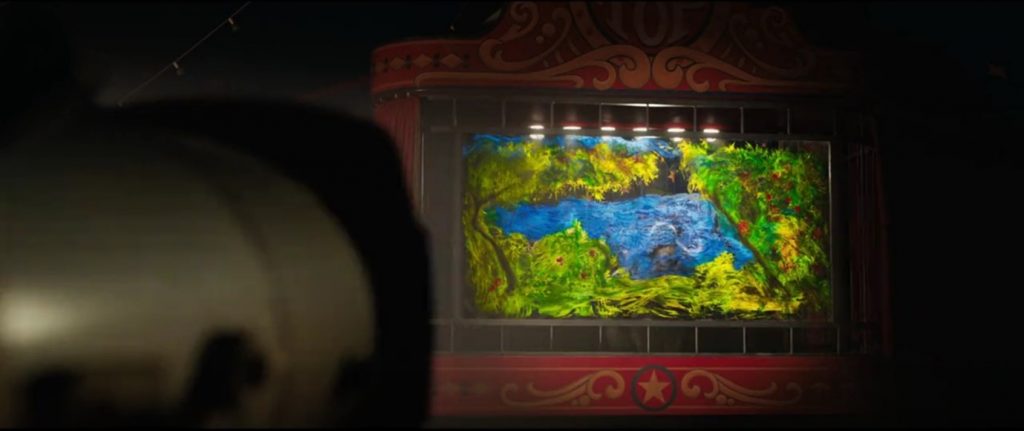
As the name of the film suggests, The One and Only Ivan showcases the individuality of animals and their much-like human personas, highlighting the injustice of their captivity. Standing out from Disney’s animated catalogue, the use of CGI (computer-generated) animals encourages the audience to interpret the unexaggerated personality of the animal protagonist by presenting them in a real-world context. Where, in animation, the viewer is inclined to accept that animals are able to enact human behaviours, such as painting for example, the film makes us realise that it is not so far-fetched. Based on a true story, the film’s eponymous silverback gorilla is represented as a creative and artistic being, with passions and desires of his own as the driving force of these qualities. The film recognises the long-standing interest in animal and especially simian artists as recent as Ivan (1962-2012), and even Congo (1954-1964) before him, a chimpanzee whose style was described as lyrical abstract impressionism. Acknowledging our fairly egotistical fascination with revealing the human-like personality and ability of animals that exists within the genre, the film suggests that the human-animal relationship, our view and valuation of them, is shaped not only by the framing of individuality but by how ‘human’ they are, given that Ivan’s abilities warrant his right to be free.
The pivotal scene where the extent of Ivan’s talent is fully realised on the window of his stage enclosure offers several cinematic shots that artfully convey his unique ability and experience through focus on his eyes. The screen here acts as a cinematic metaphor that points beyond just Ivan’s life story and frames it as a story about art and personal truth. In doing so, the film offers a unique representation of the gorilla, subverting their aggressive stereotype but illuminating more than just the ‘soft-side’ of the animal that is often expected from the genre.

Figure 2: Ivan behind his painted window 
Figure 3: Ivan’s profile
In the first shot, framed upon the transparent window, one eye peeks through the vibrant strokes of his painting (figure 2). The painting’s complete dominance of the frame, paired with Ivan’s centring, create the impression that we are seeing through this eye, the painting a projection of a crucial memory. Never has the idea that ‘eyes are the window to the soul’ felt so appropriate, as looking into them, we are forced to see the contents of his soul, his belongingness to the wild, mapped out on the window. The animal is being used here to thematise the profound and freeing importance of art as the narrative proves that Ivan’s talent is incredibly moving to the extent that he is able to effectuate change in his life. The motivation behind this message, the self-serving human gaze, places value on the ‘humanness’ of the gorilla and his ability to create in order to justify and venerate our own artistic pursuits. This is effectively conveyed using this type of animal protagonist, one already so closely related to humans.

The scene cuts to a close-up shot that positions Ivan’s profile opposite his window painting, although we know he is stood behind it (figure 3). This eye-level camera angle and the mise-en-scène, in that the two elements are presented symmetrically in equal parts, frame the gorilla and the painting as reflections of one another. This parallel suggests his entire being is characterised by his artistry and the use of cinematography therefore encapsulates the notion that animals are capable of agency and distinctly individual attributes.
His presentation as a perceptive and creative genius reminds us that animals are not so different from humans, and although Ivan’s abilities are dramatised for the film, it is the gorilla’s character expressed by the painting that constitutes an evocative animal representation. Ivan’s story is a great example of the success of expressing personal authenticity in the relationship between art and popular culture. In this manner, by foregrounding his capabilities and sensibilities, the film condemns his captivity in the Big Top Mall. In light of these, the implied violation of the human-animal boundary represented by the window seems even more unjust.

Figure 5: Stage lights illuminate Ivan’s enclosure
The shadow on the window (figure 2) visually reflects his absence from the imagined landscape at the hands of humans and places this omitted figure in opposition with the reality of the gorilla’s existence in captivity. Ivan’s differentiation from this figure and displacement from the image cement our impression of the window as a boundary that reflects and warns us of human’s unnatural intervention in the lives of animals, as well as the obstacle preventing him from his deep authentic self. The concluding shot of the scene depicts Ivan and his painting in full shot (figure 5), revealing the curtained staging surrounding his enclosure to suggest his commodification and being regarded as a spectacle, place emphasis on his inability to reach the wild, and reinforce his harsh reality despite his discernible individuality.